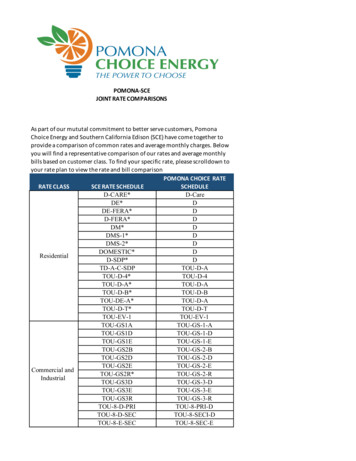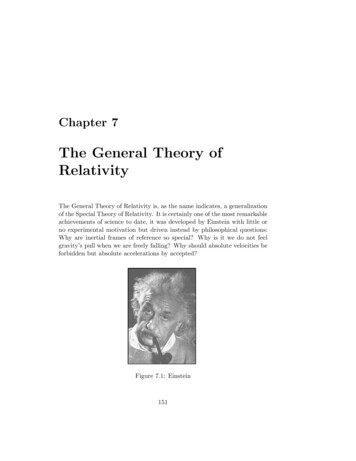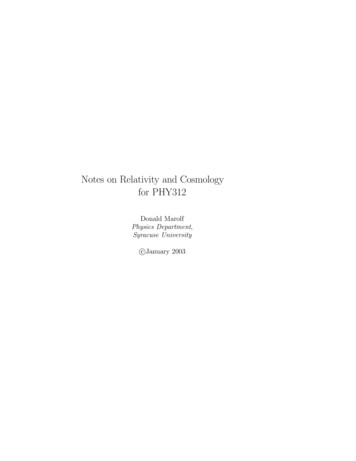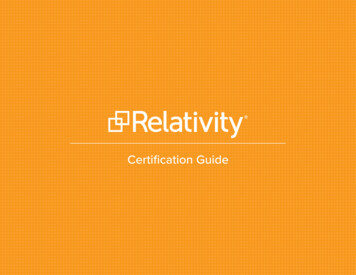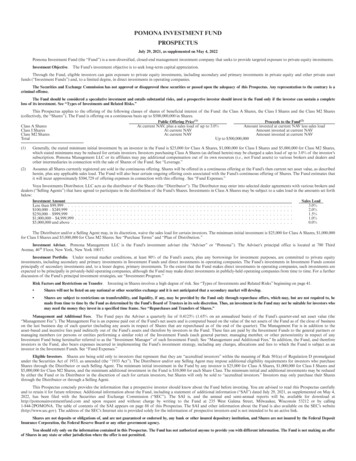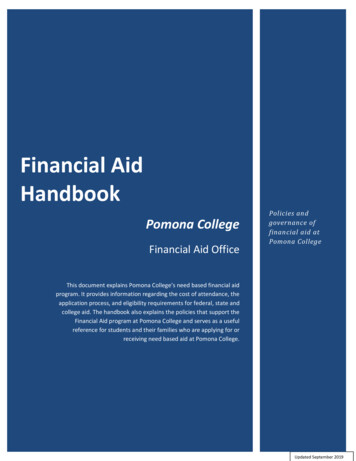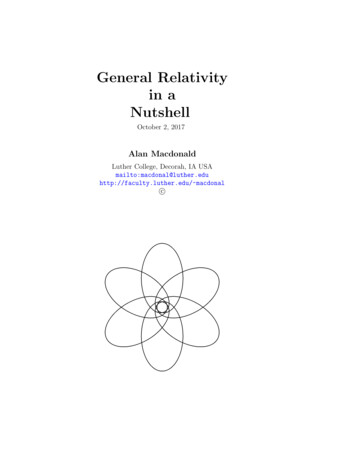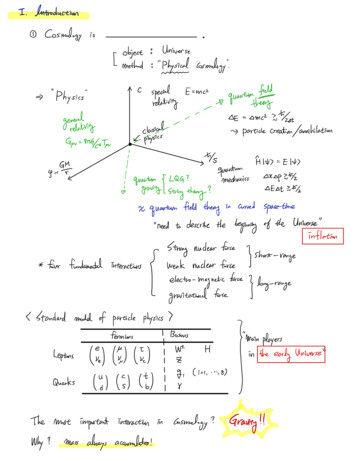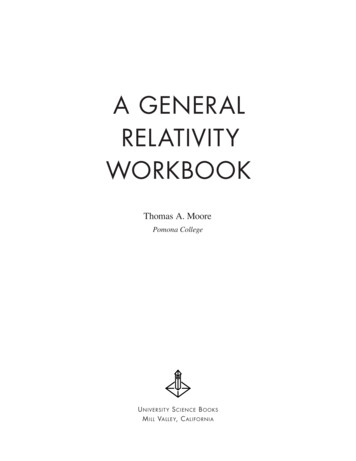
Transcription
A GENERALRELATIVITYWORKBOOKThomas A. MoorePomona CollegeU n i v ers it y S ci en ce B o o ksM i l l Va l l e y, C a l i fo rn i a
University Science Bookswww.uscibooks.comProduction Manager: Paul AnagnostopoulosText Design: Yvonne TsangCover Deisign: Genette Itoko McGrewManuscript Editor: Lee YoungIllustrator: Laurel MullerCompositor: CohographicsPrinter & Binder: Victor GraphicsCopyright 2013 by University Science BooksISBN 978-1-891389-82-5This book is printed on acid-free paper.Reproduction or translation of any part of this work beyond that permitted by Section 107 or 108 of the1976 United States Copyright Act without the permission of the copyright owner is unlawful. Requests forpermission or further information should be addressed to the Permissions Department, University Science Books.Library of Congress Cataloging-in-Publication DataMoore, Thomas A. (Thomas Andrew)A general relativity workbook / Thomas A. Moore, Pomona College.pages cmIncludes index.ISBN 978-1-891389-82-5 (alk. paper)1. General relativity (Physics) I. Title.QC173.6.M66 2012530.11—dc232012025909Printed in North America10 9 8 7 6 5 4 3 2 1
For Joyce, whose miraculous love always supports me andallows me to take risks with life that I could not face alone,and for Edwin Taylor, whose book with Wheeler set me on this path decades ago,and whose gracious support and friendship has kept me going.
CONTENTSPrefacexv1.INTRODUCTION 1Concept Summary 2Homework Problems 9General Relativity in a Nutshell 112.REVIEW OF SPECIAL RELATIVITY 13Concept Summary 14Box 2.1 Overlapping IRFs Move with Constant Relative Velocities 19Box 2.2 Unit Conversions Between SI and GR Units 20Box 2.3 One Derivation of the Lorentz Transformation 21Box 2.4 Lorentz Transformations and Rotations 25Box 2.5 Frame-Independence of the Spacetime Interval 26Box 2.6 Frame-Dependence of the Time Order of Events 26Box 2.7 Proper Time Along a Path 27Box 2.8 Length Contraction 27Box 2.9 The Einstein Velocity Transformation 28Homework Problems 293.FOUR-VECTORS 31Concept Summary 32Box 3.1 The Frame-Independence of the Scalar Product 36Box 3.2 The Invariant Magnitude of the Four-Velocity 36Box 3.3 The Low-Velocity Limit of u 37Box 3.4 Conservation of Momentum or Four-momentum? 38Box 3.5 Example: The GZK Cosmic-Ray Energy Cutoff 40Homework Problems 424.INDEX NOTATION 43Concept Summary 44Box 4.1 Behavior of the Kronecker Delta 48Box 4.2 EM Field Units in the GR Unit System 48Box 4.3 Electromagnetic Equations in Index Notation 49Box 4.4 Identifying Free and Bound Indices 50Box 4.5 Rule Violations 50Box 4.6 Example Derivations 51Homework Problems 52vii
viii CONTENTS5.ARBITRARY COORDINATES 53Concept Summary 54Box 5.1 The Polar Coordinate Basis 58Box 5.2 Proof of the Metric Transformation Law 59Box 5.3 A 2D Example: Parabolic Coordinates 60Box 5.4 The LTEs as an Example General Transformation 62Box 5.5 The Metric Transformation Law in Flat Space 62Box 5.6 A Metric for a Sphere 63Homework Problems 636.TENSOR EQUATIONS 65Concept Summary 66Box 6.1 Example Gradient Covectors 70Box 6.2 Lowering Indices 71Box 6.3 The Inverse Metric 72Box 6.4 The Kronecker Delta Is a Tensor 73Box 6.5 Tensor Operations 73Homework Problems 757.MAXWELL’S EQUATIONS 77Concept Summary 78Box 7.1 Gauss’s Law in Integral and Differential Form 82Box 7.2 The Derivative of m2 83Box 7.3 Raising and Lowering Indices in Cartesian Coordinates 83Box 7.4 The Tensor Equation for Conservation of Charge 84Box 7.5 The Antisymmetry of F Implies Charge Conservation 85Box 7.6 The Magnetic Potential 86Box 7.7 Proof of the Source-Free Maxwell Equations 87Homework Problems 888.GEODESICS 89Concept Summary 90Box 8.1 The Worldline of Longest Proper Time in Flat Spacetime 93Box 8.2 Derivation of the Euler-Lagrange Equation 94Box 8.3 Deriving the Second Form of the Geodesic Equation 95Box 8.4 Geodesics for Flat Space in Parabolic Coordinates 96Box 8.5 Geodesics for the Surface of a Sphere 98Box 8.6 The Geodesic Equation Does Not Determine the Scale of x 100Box 8.7 Light Geodesics in Flat Spacetime 101Homework Problems 1029.THE SCHWARZSCHILD METRIC 105Concept Summary 106Box 9.1 Radial Distance 110Box 9.2 Falling from Rest in Schwarzschild Spacetime 111Box 9.3 GM for the Earth and the Sun 112Box 9.4 The Gravitational Redshift for Weak Fields 112Homework Problems 114
CONTENTS ix10. PARTICLE ORBITS 115Concept Summary 116Box 10.1 Schwarzschild Orbits Must Be Planar 120Box 10.2 The Schwarzschild “Conservation of Energy” Equation 121Box 10.3 Deriving Conservation of Newtonian Energy for Orbits 122Box 10.4 The Radii of Circular Orbits 122Box 10.5 Kepler’s Third Law 124Box 10.6 The Innermost Stable Circular Orbit (ISCO) 125Box 10.7 The Energy Radiated by an Inspiraling Particle 126Homework Problems 12711. PRECESSION OF THE PERIHELION 129Concept Summary 130Box 11.1 Verifying the Orbital Equation for u(z) 135Box 11.2 Verifying the Newtonian Orbital Equation 135Box 11.3 Verifying the Equation for the Orbital “Wobble” 136Box 11.4 Application to Mercury 136Box 11.5 Constructing the Schwarzschild Embedding Diagram 137Box 11.6 Calculating the Wedge Angle d 138Box 11.7 A Computer Model for Schwarzschild Orbits 138Homework Problems 14112. PHOTON ORBITS 143Concept Summary 144Box 12.1 The Meaning of the Impact Parameter b 148Box 12.2 Derivation of the Equation of Motion for a Photon 148Box 12.3 Features of the Effective Potential Energy Function for Light 149Box 12.4 Photon Motion in Flat Space 149Box 12.5 Evaluating 4-Vector Components in an Observer’s Frame 150Box 12.6 An Orthonormal Basis in Schwarzschild Coordinates 150Box 12.7 Derivation of the Critical Angle for Photon Emission 151Homework Problems 15213. DEFLECTION OF LIGHT 153Concept Summary 154Box 13.1 Checking Equation 13.2 159Box 13.2 The Differential Equation for the Shape of a Photon Orbit 160Box 13.3 The Differential Equation for the Photon “Wobble” 160Box 13.4 The Solution for u(z) in the Large-r Limit 161Box 13.5 The Maximum Angle of Light Deflection by the Sun 161Box 13.6 The Lens Equation 162Box 13.7 The Ratio of Image Brightness to the Source Brightness 163Homework Problems 16414. EVENT HORIZON 167Concept Summary 168Box 14.1 Finite Distance to r 2GM 172Box 14.2 Proper Time for Free Fall from r R to r 0 174
x CONTENTSBox 14.3 The Future Is Finite Inside the Event HorizonHomework Problems 17617515. ALTERNATIVE COORDINATES 179Concept Summary 180Box 15.1 Calculating 2ct/2r 184Box 15.2 The Global Rain Metric 185Box 15.3 The Limits on dr/dtc Inside the Event Horizon 185Box 15.4 Transforming to Kruskal-Szekeres Coordinates 186Homework Problems 18816. BLACK HOLE THERMODYNAMICS 189Concept Summary 190Box 16.1 Free-fall Time to the Event Horizon from r 2GM f 194Box 16.2 Calculating E3 195Box 16.3 Evaluating kB, &, and T for a Solar-Mass Black Hole 196Box 16.4 Lifetime of a Black Hole 197Homework Problems 19817. THE ABSOLUTE GRADIENT 199Concept Summary 200Box 17.1 Absolute Gradient of a Vector 204Box 17.2 Absolute Gradient of a Covector 204Box 17.3 Symmetry of the Christoffel Symbols 205Box 17.4 The Christoffel Symbols in Terms of the Metric 205Box 17.5 Checking the Geodesic Equation 206Box 17.6 A Trick for Calculating Christoffel Symbols 206Box 17.7 The Local Flatness Theorem 207Homework Problems 21018. GEODESIC DEVIATION 211Concept Summary 212Box 18.1 Newtonian Tidal Deviation Near a Spherical Object 216Box 18.2 Proving Equation 18.9 217Box 18.3 The Absolute Derivative of n 217Box 18.4 Proving Equation 18.14 218Box 18.5 An Example of Calculating the Riemann Tensor 218Homework Problems 22019. THE RIEMANN TENSOR 221Concept Summary 222Box 19.1 The Riemann Tensor in a Locally Inertial Frame 224Box 19.2 Symmetries of the Riemann Tensor 225Box 19.3 Counting the Riemann Tensor’s Independent Components 226Box 19.4 The Bianchi Identity 227Box 19.5 The Ricci Tensor Is Symmetric 228Box 19.6 The Riemann and Ricci Tensors and R for a Sphere 228Homework Problems 230
CONTENTS xi20. THE STRESS-ENERGY TENSOR 231Concept Summary 232Box 20.1 Why the Source of Gravity Must Be Energy, Not Mass 236Box 20.2 Interpretation of T ij in a Locally Inertial Frame 236Box 20.3 The Stress-Energy Tensor for a Perfect Fluid in Its Rest LIF 237Box 20.4 Equation 20.16 Reduces to Equation 20.15 239Box 20.5 Fluid Dynamics from Conservation of Four-Momentum 239Homework Problems 24121. THE EINSTEIN EQUATION 243Concept Summary 244Box 21.1 The Divergence of the Ricci Tensor 248Box 21.2 Finding the Value of b 249Box 21.3 Showing that –R 4K lT 250Homework Problems 25122. INTERPRETING THE EQUATION 253Concept Summary 254Box 22.1 Conservation of Four-Momentum Implies 0 d o (t0 u o) 258Box 22.2 The Inverse Metric in the Weak-Field Limit 258Box 22.3 The Riemann Tensor in the Weak-Field Limit 259Box 22.4 The Ricci Tensor in the Weak-Field Limit 260Box 22.5 The Stress-Energy Sources of the Metric Perturbation 261Box 22.6 The Geodesic Equation for a Slow Particle in a Weak Field 262Homework Problems 26323. THE SCHWARZSCHILD SOLUTION 265Concept Summary 266Box 23.1 Diagonalizing the Spherically-Symmetric Metric 270Box 23.2 The Components of the Ricci Tensor 271Box 23.3 Solving for B 274Box 23.4 Solving for a(r) 275Box 23.5 The Christoffel Symbols with t-t as Subscripts 275Homework Problems 27624. THE UNIVERSE OBSERVED 279Concept Summary 280Box 24.1 Measuring Astronomical Distances in the Solar System 284Box 24.2 Determining the Distance to Stellar Clusters 286Box 24.3 How the Doppler Shift Is Connected to Radial Speed 287Box 24.4 Values of the Hubble Constant 288Box 24.5 Every Point Is the Expansion’s “Center” 288Box 24.6 The Evidence for Dark Matter 289Homework Problems 29025. A METRIC FOR THE COSMOS 293Concept Summary 294Box 25.1 The Universal Ricci Tensor 298
xii CONTENTSBox 25.2 Raising One Index of the Universal Ricci Tensor 298Box 25.3 The Stress-Energy Tensor with One Index Lowered 298Box 25.4 The Einstein Equation with One Index Lowered 301Box 25.5 Verifying the Solutions for q 302Homework Problems 30326. EVOLUTION OF THE UNIVERSE 305Concept Summary 306Box 26.1 The Other Components of the Einstein Equation 310Box 26.2 Consequences of Local Energy/Momentum Conservation 311Box 26.3 Deriving the Density/Scale Relationship for Radiation 312Box 26.4 Deriving the Friedman Equation 312Box 26.5 The Friedman Equation for the Present Time 313Box 26.6 Deriving the Friedman Equation in Terms of the Omegas 313Box 26.7 The Behavior of a Matter-Dominated Universe 314Homework Problems 31527. COSMIC IMPLICATIONS 317Concept Summary 318Box 27.1 Connecting the Redshift z to the Hubble Constant 322Box 27.2 Deriving the Hubble Relation in Terms of Redshift z 322Box 27.3 The Luminosity Distance 323Box 27.4 The Differential Equation for a(h) 323Box 27.5 How to Generate a Numerical Solution for Equation 27.18 324Homework Problems 32528. THE EARLY UNIVERSE 327Concept Summary 328Box 28.1 Single-Component Universes 332Box 28.2 The Transition to Matter Dominance 333Box 28.3 The Time-Temperature Relation 333Box 28.4 Neutrino Decoupling 335Box 28.5 The Number Density of Photons 337Homework Problems 33829. CMB FLUCTUATIONS AND INFLATION 339Concept Summary 340Box 29.1 The Angular Width of the Largest CMB Fluctuations 345Box 29.2 The Equation for Xk (t ) 346Box 29.3 Cosmic Flatness at the End of Nucleosynthesis 347Box 29.4 The Exponential Inflation Formula 347Box 29.5 Inflation Calculations 348Homework Problems 34930. GAUGE FREEDOM 351Concept Summary 352Box 30.1 The Weak-Field Einstein Equation in Terms of hno 355Box 30.2 The Trace-Reverse of hno 356
CONTENTS xiiiBox 30.3 The Weak-Field Einstein Equation in Terms of H no 357Box 30.4 Gauge Transformations of the Metric Perturbations 358Box 30.5 A Gauge Transformation Does Not Change Rabno 359Box 30.6 Lorentz Gauge 360Box 30.7 Additional Gauge Freedom 361Homework Problems 36131. DETECTING GRAVITATIONAL WAVES 363Concept Summary 364Box 31.1 Constraints on Our Trial Solution 368Box 31.2 The Transformation to Transverse-Traceless Gauge 369Box 31.3 A Particle at Rest Remains at Rest in TT Coordinates 371Box 31.4 The Effect of a Gravitational Wave on a Ring of Particles 372Homework Problems 37332. GRAVITATIONAL WAVE ENERGY 375Concept Summary 376Box 32.1 The Ricci Tensor 379Box 32.2 The Averaged Curvature Scalar 379Box 32.3 The General Energy Density of a Gravitational Wave 379Homework Problems 38233. GENERATING GRAVITATIONAL WAVES 383Concept Summary 384Box 33.1 H tn for a Compact Source whose CM is at Rest 388Box 33.2 A Useful Identity 388Box 33.3 The Transverse-Traceless Components of Ano 390jkBox 33.4 How to Find IpTTfor Waves Moving in the nv Direction 391Box 33.5 Flux in Terms of I j k 393Box 33.6 Evaluating the Integrals in the Power Calculation 394Homework Problems 39534. GRAVITATIONAL WAVE ASTRONOMY 397Concept Summary 398Box 34.1 The Dumbbell I j k 402Box 34.2 The Power Radiated by a Rotating Dumbbell 403Box 34.3 The Total Energy of an Orbiting Binary Pair 404Box 34.4 The Time-Rate-of-Change of the Orbital Period 404Box 34.5 Characteristics of k Boötis 405Homework Problems 40635. GRAVITOMAGNETISM 407Concept Summary 408Box 35.1 The Lorentz Condition for the Potentials 412Box 35.2 The Maxwell Equations for the Gravitational Field 413Box 35.3 The Gravitational Lorentz Equation 414Box 35.4 The “Gravitomagnetic Moment” of a Spinning Object 414Box 35.5 Angular Speed of Gyroscope Precession 415Homework Problems 416
xiv CONTENTS36. THE KERR METRIC 417Concept Summary 418v - vrBox 36.1 Expanding R-1to First Order in r/R 421Box 36.2 The Integral for h 422Box 36.3 Why the Other Terms in the Expansion Integrate to Zero 423Box 36.4 Transforming the Weak-Field Solution to Polar Coordinates 424Box 36.5 The Weak-Field Limit of the Kerr Metric 425Homework Problems 426tx37. PARTICLE ORBITS IN KERR SPACETIME 427Concept Summary 428Box 37.1 Calculating Expressions for dt/dx and dz/dx 431Box 37.2 Verify the Value of [gtz] 2 - gtt gzz 432Box 37.3 The “Energy-Conservation-Like” Equation of Motion 433Box 37.4 Kepler’s Third Law 434Box 37.5 The Radii of ISCOs When a GM 435Homework Problems 43638. ERGOREGION AND HORIZON 437Concept Summary 438Box 38.1 The Radii Where gtt 0 441Box 38.2 The Angular Speed Range When dr and/or di 0 442Box 38.3 Angular-Speed Limits in the Equatorial Plane 443Box 38.4 The Metric of the Event Horizon’s Surface 444Box 38.5 The Area of the Outer Kerr Event Horizon 445Box 38.6 Transformations Preserve the Metric Determinant’s Sign 445Homework Problems 44739. NEGATIVE-ENERGY ORBITS 449Concept Summary 450Box 39.1 Quadratic Form for Conservation of Energy 454Box 39.2 The Square Root Is Zero at the Event Horizon 454Box 39.3 Negative e Is Possible Only in the Ergoregion 456Box 39.4 The Fundamental Limit on dM in Terms of dS 457Box 39.5 dMir 0 458Box 39.6 The Spin Energy Contribution to a Black Hole’s Mass 459Homework Problems 460Appendix: A Diagonal Metric Worksheet 463Index467
PREFACEIntroductory Comments. General relativity is one of the greatest triumphs of the human mind. Together with quantum field theory, general relativity lies at the foundationof contemporary physics, and currently represents the most durable physical theory inexistence, having survived nearly a century of development and increasingly rigoroustesting without being contradicted or superseded. Long admired for its elegant beauty,general relativity has also (particularly in the past two decades) become an essentialtool for working physicists. It provides the basis for understanding a huge variety ofastrophysical phenomena ranging from active galactic nuclei, quasars, and pulsars tothe formation, characteristics and destiny of the universe itself. It has driven the development of new experimental tools for testing the theory and for the detection of gravitational waves that represent one of the most lively and challenging areas of contemporary physics. Even engineers are starting to have to pay attention to general relativity:making the Global Positioning System function correctly requires careful attention togeneral relativistic effects.In some ways, general relativity was so far ahead of its time that it took a long timefor instrumentation and applications to catch up sufficiently to make it more than thanan intellectual adventure for the curious. However, as general relativity has now movedfirmly into the mainstream of contemporary physics with a wide and growing varietyof applications, teaching general relativity to undergraduate physics majors has becomeboth relevant and important, and the need for appropriate and up-to-date undergraduate-level textbooks has become urgent.Audience. This textbook seeks to support a one-semester introduction to general relativity for junior and/or senior undergraduates. It assumes only that students have takenmultivariable calculus and some intermediate Newtonian mechanics beyond a standardtreatment of mechanics and electricity and magnetism at the introductory level (thoughstudents who have also taken linear algebra, differential equations, some electrodynamics and/or some special relativity will be able to move through the book more quicklyand easily). This book has grown out of my experience teaching fourteen iterations ofsuch an undergraduate course during my teaching career.Those iterations have convinced me that undergraduates not only can develop asolid proficiency with the general relativity, but also that studying general relativityprovides a superb introduction to the best practices of theoretical physics as well asa uniquely exciting and engaging introduction to ideas at the very frontier of physics,things that students rarely experience in other undergraduate courses.Pedagogical Principles. Since students rarely see the tensor calculus used in generalrelativity in undergraduate mathematics courses, a course in general relativity musteither teach this mathematics from scratch or seek to work around it (at some cost in coherence and depth of insight). In my experience, junior and senior undergraduates canmaster tensor calculus in an appropriately designed course, and that doing this is wellworth the effort, as it provides the firm foundation needed for confidence and flexibilityin confronting applications.The pedagogical key for developing this mastery is for you (the student) to personally own the mathematics by working through most of the arguments and derivationsxv
xvi PREFACEyourself. Therefore, I have designed this textbook as a workbook. Each chapter openswith a concise core-concept presentation that helps you see the big picture withoutmathematical distraction. This presentation is keyed to subsequent “boxes” that I havedesigned to guide you in working through the supporting derivations as well as other details and applications whose direct presentation would obscure the core ideas. Ihave found this combination of overview and guided effort to be uniquely effective inbuilding a practical understanding of the theory’s core concepts and their mathematicalfoundations.The overview-and-box design also helps keep you focused on the physics as opposed to the mathematics, underlining how the mathematics supports and expresses thephysics. Other aspects of the textbook’s design also support the principle that the physics should be foremost. I have ordered the topics so that the mathematics is presentednot in one big lump but rather gradually and “as needed,” thus allowing the physics todrive the presentation. For example, you will extensively practice using tensor notationby exploring real physical applications in flat space before learning about the geodesicequation that describes an object’s motion in a curved spacetime. You will then spenda great deal of time exploring the physical implications of the geodesic equation inthe particular curved spacetime surrounding a simple spherical object before learningthe additional mathematical tools required to show why spacetime is curved in thatparticular way around a spherical object. Along the way, I use many “toy” examples intwo-dimensional flat and curved spaces help develop your intuitive understanding ofthe physical meaning of the core ideas. The gradual development of the mathematicsthroughout the text also helps ensure that you have time to gain a firm footing for eachstep before continuing the climb.The key to using this book successfully is working carefully through all the boxesin this book. Doing this will ultimately provide you with a range of experience anddepth of understanding difficult to obtain any other way.Chapter Dependencies. The chart that appears on each chapter’s title page (and on thenext page) shows how the major sections of the book depend on each other. For example, you can see from the chart that the Introduction, Flat Space, and Tensors sections(chapters 1 through 8) provide core material that every other section uses. After chapter8, I strongly recommend going on to the Schwarzschild Black Holes section, becausethis will develop your understanding of how to work with curved spacetimes beforehaving to wrestle with yet more math (and because black holes are fascinating applications of the theory). However, this is not essential; in a short course focused on cosmology, for example, one could go directly on to the Calculus of Curvature, EinsteinEquation, and Cosmology sections. Note also that the final three sections (Cosmology,Gravitational Waves, and Spinning Black Holes) are completely independent of eachother and can be explored in any order one might choose. However, all three of thesesections require the Calculus of Curvature and Einstein Equation sections.One also does not have to go all the way through the Schwarzschild section. Thelast three chapters (on black holes) are only necessary if you also plan to go throughthe last two chapters of the Spinning Black Holes section (though it is hard to imaginewhy anyone would want to avoid learning about black holes!). One can easily omit theDeflection of Light chapter without loss of continuity. The Precession of the Perihelionchapter is necessary background for the Deflection of Light chapter, but you could omitboth. The first two chapters are required for all of the other chapters in this section, andthe fourth chapter on Photon Orbits presents a mathematical technique that is employedin certain homework problems throughout the rest of the book, but is only absolutelyrequired for the Deflection of Light and the Black Hole Thermodynamics chapters.In the Cosmology section, the first four chapters provide core material and shouldall be included if this section is to be explored at all. The last two chapters, however, arecompletely optional; you can omit either both or the last, as desired.
PREFACE xviiINTRODUCTIONFLAT SPACETIMESCHWARZSCHILDBLACK HOLESTENSORSReview of Special RelativityArbitrary CoordinatesThe Schwarzschild MetricFour-VectorsTensor EquationsParticle OrbitsIndex NotationMaxwell’s EquationsPrecession of the Perihelion*GeodesicsPhoton OrbitsDeflection of Light*Event Horizon*THE CALCULUSOF CURVATURETHE EINSTEINEQUATIONThe Absolute GradientThe Stress-Energy TensorGeodesic DeviationThe Einstein EquationThe Riemann TensorInterpreting the EquationAlternative Coordinates*Black Hole Thermodynamics*The Schwarzschild SolutionCOSMOLOGYSPINNINGBLACK HOLESGRAVITATIONALWAVESThe Universe ObservedGauge FreedomGravitomagnetism*A Metric for the CosmosDetecting Gravitational WavesThe Kerr Metric*Evolution of the UniverseGravitational Wave Energy*Kerr Particle Orbits*Cosmic ImplicationsGenerating Gravitational Waves*Ergoregion and Horizon*The Early Universe*Gravitational Wave Astronomy*Negative-Energy Orbits*CMB Fluctuations & Inflation*thisdepends onthisA chart showing the chapters of the book grouped in their major sections and how those sections depend on each other.Chapters marked with a * are optional, though later optional chapters typically depend on earlier such chapters.While in principle it is possible to stop at after the first two chapters in the Gravitational Wave section, I think that a discussion of gravitational wave energy and generation is pretty important. I therefore recommend going through at least the first threechapters of this section if you want to explore gravitational waves at all.One might reasonably elect to explore the Gravitomagnetism chapter alone in theSpinning Black Holes section, or stop after either the Kerr Particle Orbits chapter or
xviii PREFACEthe Ergoregion and Horizon chapter. However, the chapters in this section do need tobe discussed in sequence; one cannot easily drop one from the middle.The First Chapter. Please also note that the first chapter has a different structure thanthe others. After dealing with preliminaries, I usually end the first class session of thecourse I teach with a 40-minute interactive lecture. For the sake of completeness (andfor later reference), I have provided in the first chapter what amounts to a polishedtranscript of that lecture. This chapter has no boxes because I don’t expect my studentsto have read (or perhaps even own) the book before the first class. To help them trackthe lecture, I instead give them a two-sided handout that appears as the last two pagesof the first chapter.The Second Chapter. This chapter presents a very terse review of special relativityaimed primarily at students that have already encountered some relativity in a previouscourse. If you have not seen relativity before, you may find this chapter harder going.Even so, everything you need to know about special relativity for this book is presentedthere, and if you work through the chapter slowly, and do many of the homework problems, you should be fine. I have also included references to supplemental reading thatyou may find helpful.Book Website. You can find a variety of other helpful information and supportingcomputer software on this textbook’s website:http://pages.pomona.edu/ tmoore/grw/Please also feel free to email me suggestions, questions, and error notices: my emailaddress is tmoore@pomona.edu.Information for Instructors. So far in this preface, I have addressed issues of concern to all readers in language directed mostly to students. In the remainder, I want tospecifically address issues of interest to instructors who are designing undergraduatecourses around this book.Course Pacing. I have designed the text so that (in my experience) each chapter cangenerally be discussed in a single (50-minute) class session, particularly if you usethe format for class sessions I describe below. Your mileage may vary (for example,you may need to spend more time on chapter 2 if your students’ background in specialrelativity is weak), but this general rule should help you appropriately pace the course.You also have a lot flexibility in choosing which chapters to cover and which youmight omit: there are at least twenty different chapter sequences that make sense. Besure to examine thoroughly the section above on Chapter Dependencies above beforedesigning a syllabus that omits chapters. However, I find that I can usually get throughthe entire book in one semester.Let me emphasize again that the last three sections (Cosmology, GravitationalWaves, and Spinning Black Holes) are independent; you can present them in any order. One of my colleagues likes to end the course with cosmology, which he thinksprovides an exciting climax. I have made that section first of the three precisely becauseI also think it is the most important. If I am working through the book sequentially andrun out of time, I’d rather do so in the Spinning Black Holes section than omit any of thecosmology material! I also find that students have many other pressures and concernsnear the end of the semester, so I tend to schedule material that I consider less crucialtoward the end. But you can certainly choose what works best for you and your students,and you have lots of flexibility to do so.How to Spend Class Time. The workbook format will push students to gain masteryonly if your course design somehow rewards students for filling out the boxes. The last
PREFACE xixtime I taught the course, I asked several students chosen at random each class sessionto hand me their books, which I subsequently graded for thoughtful effort in fillingout the boxes since the last time they submitted their book, with special emphasis onthe chapter discussed in class that day. Each student’s average grade for these randomsamples counted about 13% of their course grade. I arranged things so that each studentwas called on about five to six times a semester.One of my colleagues at a another institution uses a different approach that maybe even better. After determining which box exercises seemed easy enough to skipdiscussion, he then assigns each remaining box exercise to a student in a strict rotation(including himself in the rotation). The student must present the solution in front of theclass. This strongly motivates the students to come to class prepared without having toassign a formal grade for preparation, and also makes class time a bit more active thanthe way I did it. I intend to use this approach myself the next time that I teach the course.You might find some other approach better than either of these for your students, butI consider it very important when designing a course based on this book to find someway of rewarding students for doing work in the boxes before class.In either of the approaches outlined above, we spend much of the class period discussing the challenges students encountered in going through the boxes. Because students have at least tried to work out the boxes before class, they typically bring goodquestions to the table, questions that directly address the difficulties they are experiencing personally. We are therefore able to spend class time efficiently addressing students’actual needs. If we have time (and we often do), I often work some example problemsin class, targeted toward either some interesting phys
eneral relativity workbook / Thomas A. Moore, Pomona College.A g pages cm ncludes index.I SBN 978-1-891389-82-5 (alk. paper)I.eneral relativity (Physics)1 G I. Title. QC173.6.M66 2012 530.11—dc23 . Box 15.3he Limits on T dr dt/ c Inside the Event Horizon 185. Box 15.4ransforming to Kruskal-Szekeres Coordinates T 186 Homework Problems 188

